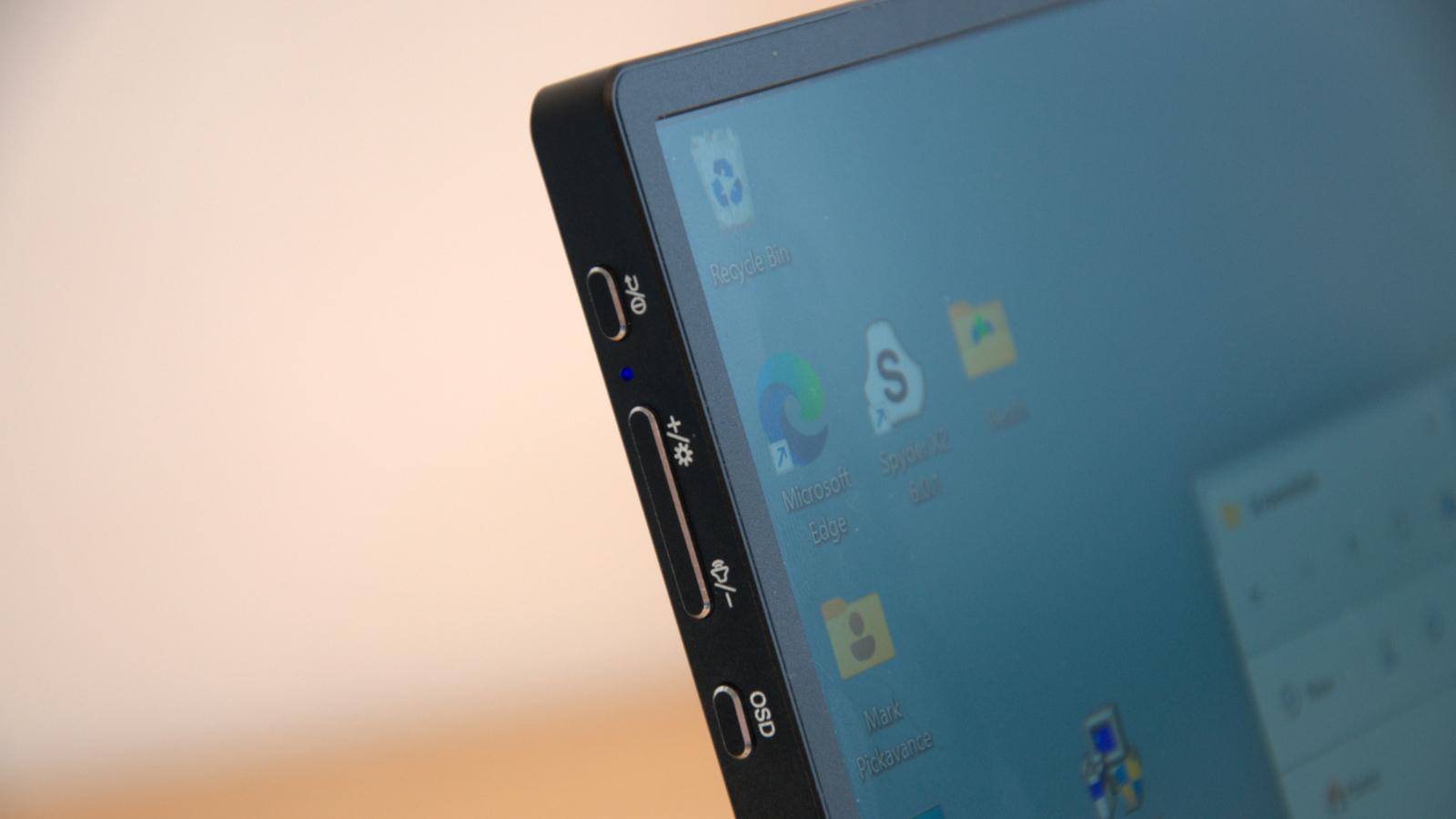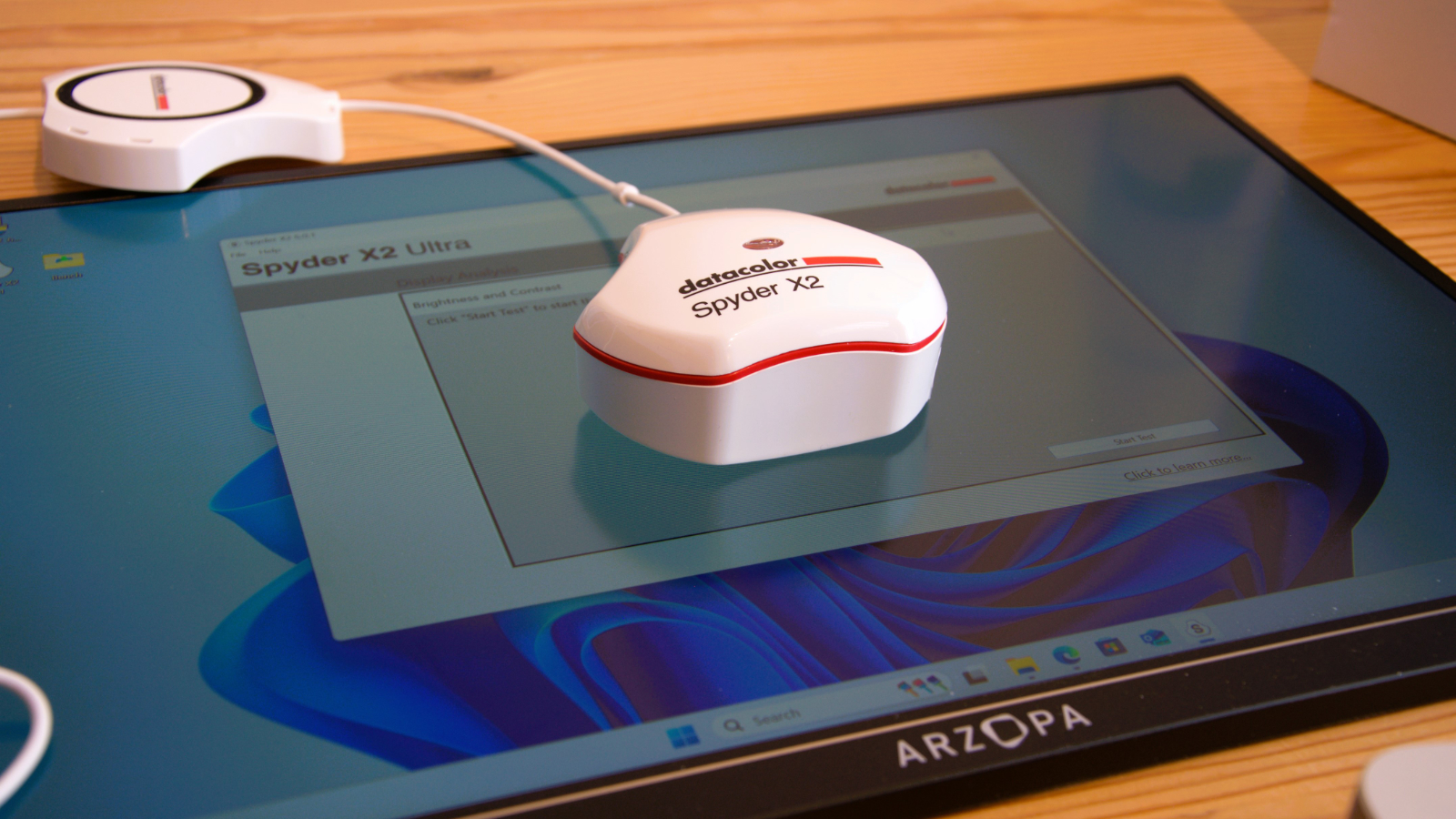TechRadar Verdict
It might not meet the colour accuracy standards that creatives might expect, but the Arzopa Z1RC is useful for those who want a second display to carry with them. It needs a better backlight for more uniform output, but it's still a bargain at this price.
Pros
- +
2560 x 1600 resolution
- +
Uses USB power
- +
Works in portrait and landscape
- +
HDMI and USB inputs
- +
Cheap
Cons
- -
Needs protection when travelling
- -
No PSU included
Why you can trust TechRadar
Arzopa Z1RC: 30-second review
The demand for portable monitors is somewhat limited as most individuals who require a computer while on the go, opt for a laptop with a built-in screen. Projectors are often utilised for those seeking an additional display, perhaps for a presentation to clients, as they allow for easy viewing by a larger audience.
The Arzopa Z1RC is designed to provide a laptop (or desktop) with a 16-inch second display that's easy to carry and connect.
In many respects, it resembles the Espresso 17 Pro we reviewed previously, except it has a smaller panel, lower resolution, and was built using cheaper components.
And, like the Espresso design, this panel is USB powered either using a typical phone charger (not included) or USB power from the host system.
Doing that with a laptop will invariably reduce battery life, though if the laptop is USB-charged and mains-powered, that shouldn't be an issue.
Display input is either through Mini HDMI or USB-C, and cables are provided in the box that convert from standard HDMI to the Mini variety. The box can also connect a PC with USB-C to one of the two ports on the monitor.
What's especially nice about this design is that it has an integrated stand that is adjustable for various viewing angles in landscape mode and works in portrait orientation.
Sign up to the TechRadar Pro newsletter to get all the top news, opinion, features and guidance your business needs to succeed!
Overall, this is a useful device for modest money if you can live with a few limitations.
Arzopa Z1RC: Price and availability

- How much does it cost? $120/£129
- When is it out? It available now
- Where can you get it? Direct from Arzopa globally or in Europe
Considering the high price of the Espresso 17 Pro display and their ergonomic similarities, the price of the Z1RC was rather shocking.
For US customers, Arzopa has reduced the price from the MSRP of $189.99 to $119.99. For UK customers, that translates into a still remarkably affordable £129.99.
That's the cost that unbranded portable monitors typically cost with a 1080p screen, so the Z1RC is a terrific value.
- Value: 5 / 5
Arzopa Z1RC: Specs
Model: | Arzopa Z1RC |
|---|---|
Screen Size: | 16-inch corner to corner |
Resolution: | 2560 x 1600 |
Compatibility: | TB4, TB3, USB 4.0, USB-C |
Number of Ports: | 2 |
Ports: | 2x USB-C, 1x Mini HDMI |
Quoted Colour Spec | 100% RGB |
Panel Bits | 8 |
Display Technology: | IPS |
Size | 356 x 240 x 9mm (W x D x H) |
Weight | 763g |
Accessories included | USB-C to USB-C, USB-A to USB-C, HDMI to Mini HDMI cables |
Touch capable | No |
Maximum refresh | 60Hz |
Arzopa Z1RC: Design

- Simple design
- Cabling options
- Inbuilt stand
What stands out most about the Z1RC is the simplicity of the design and how this makes it fit for purpose.
It's a 16-inch IPS panel with no integrated power supply, some basic controls to access a sparse OSD menu, and an inbuilt kickstand. Almost everything else is just window-dressing, to a degree.
Included in the box, along with three cables, is a short printed user guide detailing how this monitor can be attached to a host system.
If you use HDMI output, the monitor needs to source power from elsewhere, which could be the computer over USB-C or USB-A or an external power source.
The power demands are around 9W, so even a relatively small power bank can provide that power.
But, if you have a suitably equipped laptop with a USB-C port that can output those watts, then the Z1RC can be connected just by a USB-C to USB-C cable that carries both the monitor signal and the power to drive it.
On the left side are the two USB-C ports and Mini HDMI input. Alongside these are buttons that power the monitor on/off, volume and brightness adjustments, and a button to bring the OSD to the screen.
As the screen comes to life once you plug it in, the power button is largely superfluous.
The OSD menu controls brightness, contrast, sharpness, ECO options, and DCR, and you can adjust colour temperature. However, the only practical reason most owners might use the OSD is to switch sources, as you can plug two host systems into this panel.
There are speakers, but Arzopa doesn't say what size they are, and given the limited space inside the screen, they might be less than a watt.

But our favourite design feature is undoubtedly the kickstand, a metal strip with a hinge at one end that can support the screen in portrait and landscape orientations. It's simple to deploy and stow, can't be lost, and in landscape mode, it provides some options for the angle of the screen.
The natural resolution of this screen is a slightly unusual 2540 x 1600, making it marginally larger than 1440p. That seems an ideal resolution, as 1080p at this size would seem awkward with some apps, and 4K would be overkill.
The Z1RC might be basic, but it was designed to work with the minimum of fuss, and it does that successfully.
- Design: 4 / 5

Arzopa Z1RC: Performance
- Backlight uniformity issues
- 100% sRGB
- Limited viewing angles
Testing the Z1RC was another opportunity to get our Datacolor Spyder X2 Ultra out and give this display a proper shakedown.
Given that this display is IPS and only 8-bit, we reeled our expectations back somewhat. Arzopa claims this monitor has a 1200:1 contrast ratio and a maximum brightness of 500 nits, but even the best-branded monitors often don't hit their provided numbers.
While the contrast ratio was reasonably close at 1060:1, the backlight in the Z1RC isn't remotely bright enough for 500 nits, hitting closer to 337 at 100% setting.
It's probably closer to 400 nits at peak, but these are average numbers, and this screen is significantly brighter at the top edge and much darker further down the panel. The bottom edges are up to 15% darker, which would take 400 nits at the top and reduce it to 340 nits at the bottom. The lack of brightness uniformity is probably the worst aspect of the Z1RC.
Ironically, colour uniformity is better, though still top-biased.
This panel delivers the quoted 100% of the sRGB gamut, 89% of AdobeRGB, 95% of P3 and 69% of Rec 2020. For an IPS panel, these are respectable numbers, even if nobody who works with colour for a living would rush to buy one.
The Z1RC is an adequate monitor for office work or a customer presentation. However, make sure that the person viewing is perpendicular to the screen since it tends to be less bright outside the optimal viewing angles.
According to the specifications, the viewing angle range is 85 degrees in both the horizontal and vertical directions, which is on the low side for IPS technology.

- Performance: 3.5 / 5
Arzopa Z1RC: Verdict
It's easy to swipe at the Arzopa Z1RC because it's not as bright as the specifications say it should be, and the backlight is uneven. But being realistic, for the low asking price, this is a highly useful piece of equipment that someone travelling could carry that gives them more screen space.
Those wanting 100% Adobe RGB colours or a touch panel can pay much more than this for those privileges. This design isn't for that market.
This reviewer has found it excellent for use with Mini PCs, which can supply the power needed to drive the screen without a USB-C PSU.
Owners need to accept that the Z1RC isn't a device you carelessly throw into a bag, as it only comes with a 12-month warranty. But if you carry it in the box it came, it should be reasonably safe.
The Arzopa Z1RC might not be the most amazing portable monitor, but it's one that most people can afford, and many might find it invaluable.

Arzopa Z1RC: Report card
Value | Amazingly low cost for what it offers. | 5 / 5 |
Design | Simple but effective design that is easy to transport | 4 / 5 |
Performance | Backlight issues but reasonable in other respects | 3.5 / 5 |
Total | There are better portable screens, but not at this price. | 4 / 5 |
Should you buy a Arzopa Z1RC?

Buy it if...
You travel light and need a second screen
At just over 800g for the screen and the cables combined, this is a highly portable solution. However, how long it will work drawing laptop power is debatable, and it needs to be in its box to avoid damaging the panel.
You need a carry around display
Those working with a server rack often use remote access to make configuration changes, but occasionally, these need to be made in person. The Arzopa Z1RC is perfect for carrying to a server, plugging it in and seeing what messages are on the screen.
Don't buy it if...
You need colour accuracy
This monitor isn't made for colour accuracy, so if you are promoting a line of garments as an example, they might not look like the actual colours through this monitor. And, being 16-inch corner-to-corner, this screen needs to be viewed from relatively near.
You have a laptop without USB-C or HDMI
It is possible to drive the Z1RC directly with USB-C from the PC without other cables, but if you use HDMI, you need to have a USB port that can deliver 9W or an external power source. Connecting this monitor without an HDMI or USB-C port (or Thunderbolt 3/4) is impossible.
We tested the best business monitors - and these are our top choices for professionalism and productivity
Mark is an expert on 3D printers, drones and phones. He also covers storage, including SSDs, NAS drives and portable hard drives. He started writing in 1986 and has contributed to MicroMart, PC Format, 3D World, among others.

